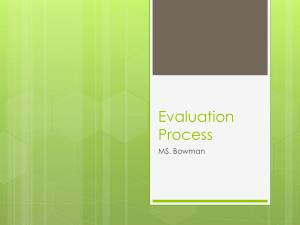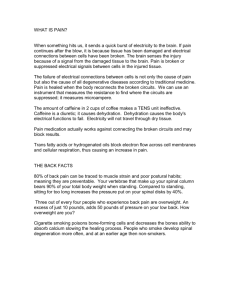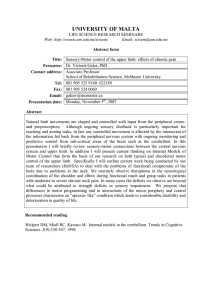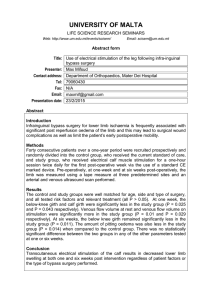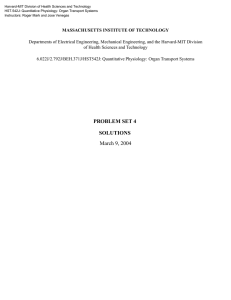Harvard-MIT Division of Health Sciences and Technology
advertisement
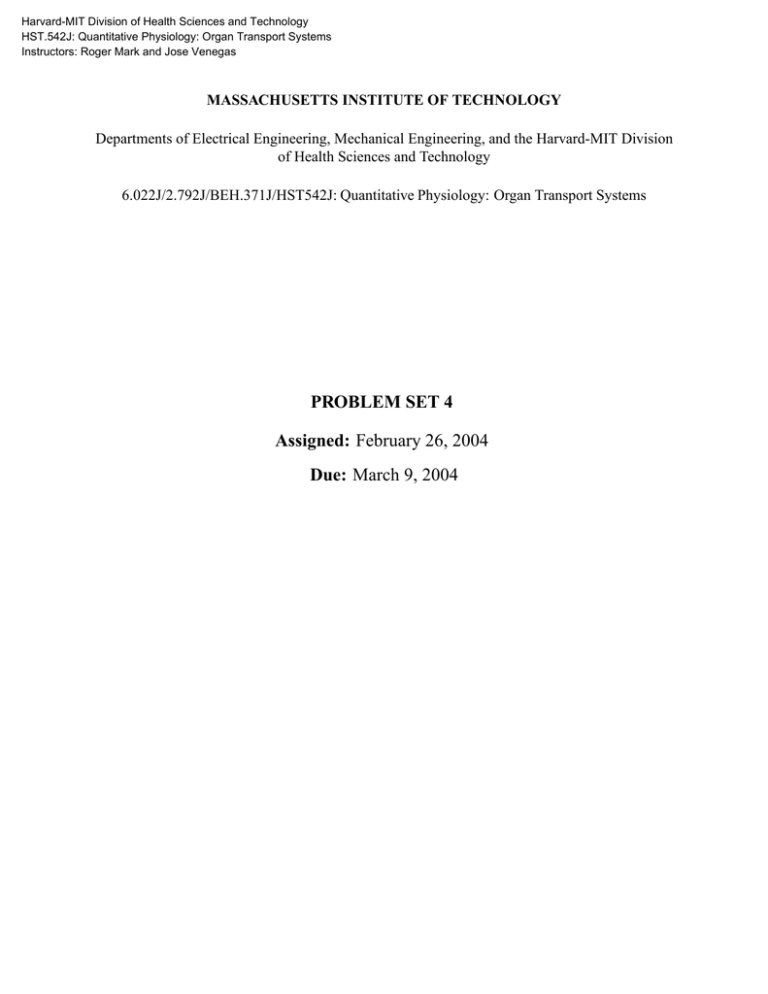
Harvard-MIT Division of Health Sciences and Technology HST.542J: Quantitative Physiology: Organ Transport Systems Instructors: Roger Mark and Jose Venegas MASSACHUSETTS INSTITUTE OF TECHNOLOGY Departments of Electrical Engineering, Mechanical Engineering, and the Harvard-MIT Division of Health Sciences and Technology 6.022J/2.792J/BEH.371J/HST542J: Quantitative Physiology: Organ Transport Systems PROBLEM SET 4 Assigned: February 26, 2004 Due: March 9, 2004 Problem 1 You are assigned to the Holter laboratory, and the Holter technician brings several rhythm strips to you, asking for advice. For each strip: • Identify the arrhythmia as completely as possible. • Draw the appropriate ladder diagram under each strip. . Image removed for copyright reasons. 2 6.022j—2004: Problem Set 4 Image removed for copyright reasons. 6.022j—2004: Problem Set 4 3 Image removed for copyright reasons. 4 6.022j—2004: Problem Set 4 Image removed for copyright reasons. 2004/178 6.022j—2004: Problem Set 4 5 Problem 2 The following hypothetical experiments are carried out on an anesthetized rabbit with intact car­ diovascular reflexes. A. A hind limb is hemodynamically isolated and perfused with a constant pressure of 100 mmHg. The flow into the femoral artery is continuously measured. The venous outflow is returned to the perfusion reservoir. The nerves supplying the vasculature of the limb are cut. For each of the following hypothetical experimental procedures, please sketch the ex­ pected changes in blood flow into the limb (use the attached graphs), and briefly explain the rationale for the changes you predict. (i) The oxygen saturation of the perfusing blood is decreased from 100% to 35% for two minutes. control O2 sat. = 35% Flow 0 1 2 3 4 t (min) (ii) The sympathetic nerve fibers are electrically stimulated for two minutes. control sympathetic stim. Flow 0 6 1 2 3 4 t (min) 6.022j—2004: Problem Set 4 (iii) The perfusion pressure to the limb is suddenly increased to 150 mmHg for two minutes. control perfusion press. = 150 Flow 0 1 2 3 4 t (min) (iv) A low dose of epinephrine (0.3 micrograms/kg.) is infused into the limb for two min­ utes. control low-dose epinephrine Flow 0 1 2 3 4 t (min) (v) A moderate dose of norepinephrine is infused for two minutes. control norepinephrine Flow 0 6.022j—2004: Problem Set 4 1 2 3 4 t (min) 7 B. The same experimental preparation is used as in part A, except that the innervation to the hind limb is left intact. Thus, the leg is perfused from a separate blood supply at a constant pressure of 100 mmHg, and the blood flow into the limb is continuously monitored. In addition, the rabbit’s ECG is monitored, and a continuous recording of heart rate is produced. The rabbit’s neck is dissected, permitting access to the carotid arteries, the aortic nerve (afferent nerve from aortic baroreceptors), and the vagus nerve. Sketch the responses you expect in the limb blood flow and the heart rate (using the attached graphs) for each of the following experimental procedures, and briefly explain your rationale: (i) Both carotid arteries are occluded for 30 seconds, then released. Flow t (min) control HR control 8 1 2 3 4 t (min) 6.022j—2004: Problem Set 4 (ii) The aortic nerve is electrically stimulated for 30 seconds. Flow t (min) control HR control 1 2 3 4 t (min) (iii) The animal (not the leg) is infused with a high dose of norepinephrine for 30 seconds. Flow t (min) control HR control 6.022j—2004: Problem Set 4 1 2 3 4 t (min) 9 (iv) The animal’s vagus nerve is stimulated electrically for 30 seconds. Flow t (min) control HR control 1 2 3 4 t (min) (v) Part iii above is repeated after cutting the aortic nerve and clamping both carotid arter­ ies. Flow t (min) control HR control 1 2 3 4 t (min) 2004/238 10 6.022j—2004: Problem Set 4 Problem 3 A patient entered the hospital in shock (very low blood pressure) with chest pain. He was found to be pale, with cool, moist skin, dilated pupils, a pulse rate of 150 bpm (weak and thready), a blood pressure of 60/30, in a semicomatose state, with very little urine output. Two possible causes for the low blood pressure were considered: • inadequate cardiac output because of damage to the left ventricle. • severe internal blood loss—possibly due to a ruptured aortic aneurysm. A. What single pressure measurement (preferably one that can be estimated by non-invasive inspection) would differentiate between the two diagnoses? Explain why, using CO/VR curves. Further examination confirmed that the problem was one of blood loss, and that the heart was normal. B. Using cardiac output/venous return curves, show the situation for this hypothetical patient with no compensatory mechanisms. (Indicate a “normal,” and then the situation with the blood loss.) C. Repeat part B but demonstrate the corresponding changes in the LV P-V domain. D. Next, discuss as many compensatory mechanisms as you can (both short-term and longterm), and indicate how each will change the PV loops and VR/CO curves. E. Explain each of the physical findings in terms of the appropriate physiology: Low BP of 60/30 Paleness Cool moist skin Dilated pupils HR — 150 Semicomatose state Low urine output 2004/76 6.022j—2004: Problem Set 4 11 Problem 4 Two men are involved in an argument in a bar. One has had a good deal to drink, the other none. Each sustains a gunshot wound to the leg and rapidly loses the same large amount of blood before the bystanders can stop the bleeding with direct pressure. Assume no other significant injury occurs. A. List in an outline form what reflexes and adjustments would be expected to take place restore the circulation to normal without therapy. Please indicate the approximate time constant of each, and make use of function curves to illustrate the recovery. (Especially cardiac output/venous return, as well as ventricular pressure/volume curves). B. Alcohol is a peripheral (both arterial and venous) dilator and indirectly a diuretic (increases urine output). Please show where this might interfere with or alter the recovery. 2004/181 12 6.022j—2004: Problem Set 4
